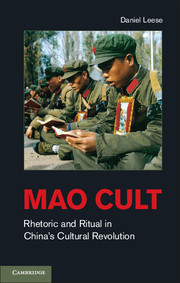Book contents
- Frontmatter
- Contents
- Illustrations, Figures, Maps, and Table
- Preface
- Chronology of Major Events
- Abbreviations
- Map Administrative divisions of China
- Introduction
- Part One Coming to Terms with the “Cult of the Individual”
- Part Two Charismatic Mobilization
- Part Three Cult and Compliance
- Conclusion
- Bibliography
- Glossary
- Index
Part One - Coming to Terms with the “Cult of the Individual”
Published online by Cambridge University Press: 07 October 2011
- Frontmatter
- Contents
- Illustrations, Figures, Maps, and Table
- Preface
- Chronology of Major Events
- Abbreviations
- Map Administrative divisions of China
- Introduction
- Part One Coming to Terms with the “Cult of the Individual”
- Part Two Charismatic Mobilization
- Part Three Cult and Compliance
- Conclusion
- Bibliography
- Glossary
- Index
Summary
In the late hours of 5 March 1953, Joseph Stalin died. The official announcement drafted in the name of the CCP Central Committee expressed the enormous grief his death had inflicted upon the Communist Party of the Soviet Union (CPSU) and the course of the world revolution. For the CCP, it was likewise a loss “the tragic consequences of which could not be fathomed.” The Chinese public had been well informed about the changing health situation of the “great leader of the world revolution,” since the CCP had regularly published accounts in the media and ordered to post daily bulletins about Stalin’s condition at major public places. During the official commemoration ceremony, Mao Zedong himself laid down a wreath of flowers in honor of the deceased at the Gate of Heavenly Peace, which had been decorated with Stalin’s portrait, and called upon the Chinese to turn their grief into renewed strength for the revolutionary cause. For three days, all of China was to commemorate the dead. All flags were to be lowered, all public institutions closed. The leader of world communism had died and despite his frequent quarrels over the correct path of the Chinese Revolution with the CCP leadership and Mao Zedong in particular, his commemoration could leave no doubt about the importance and influence Stalin had exerted on the communist movement. The enormous consequences of Stalin’s death were not only reflected within the party leadership but led to discussions among the lower-ranking cadres and the populace as well. Doubts were uttered as to whether the Soviet–Chinese alliance could carry on as it had before and questions were asked regarding how the socialist states could continue to attract further members without Stalin’s personality. By means of frequent propagation and regular study sessions, the local party committees were to counter the rising tide of skeptics and to stop the spreading of rumors about what would happen now that the helmsman of the world revolution had died.
- Type
- Chapter
- Information
- Mao CultRhetoric and Ritual in China's Cultural Revolution, pp. 25 - 26Publisher: Cambridge University PressPrint publication year: 2011

